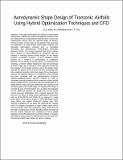Aerodynamic Shape Design of Transonic Airfoils Using Hybrid Optimization Techniques and CFD
Author(s)
Xing, X.Q.; Damodaran, Murali; Teo, Chung Piaw
DownloadHPCES001.pdf (11.48Kb)
Metadata
Show full item recordAbstract
This paper will analyze the effects of using hybrid optimization methods for optimizing objective functions that are determined by computational fluid dynamics solvers for compressible viscous flow for optimal design of airfoils. Previous studies on this topic by the authors had examined the application of deterministic optimization methods and stochastic optimization methods such as Simulated Annealing and Simultaneous Perturbation Stochastic Analysis (SPSA). The studies indicated that SPSA method has a greater or equal efficiency as compared with SA method in reaching optimal airfoil designs for the design problem in question. However, in some situations SPSA method has a tendency to demonstrate an oscillatory behavior in the vicinity of a local optima. To overcome this tendency, a hybrid method designed to take full advantage of SPSA’s high rate of reduction of the objective function at the inception of the design process to drive the design cycles towards the optimal zone at first, and then combining with other methods to perform the final stages of the convergence towards the optimal solutions is considered. SPSA method has been combined with the gradient-based Broydon-Fletcher-Goldfarb-Shanno (BFGS) method as well as Simulated Annealing method for the transonic inverse airfoil design problem that is concerned with the specification of a target airfoil surface pressure distribution and starting from an initial guess of an airfoil shape, the target airfoil shape is reached by way of minimization of a quantity that depends on the difference between the target and current airfoil surface pressure distribution. For a typical transonic flow test case, the effects of using hybrid optimization techniques such as SPSA+BFGS and SPSA+SA as opposed to using SPSA alone can be seen in Figure 1. After 800 design cycles using SPSA, the hybrid SPSA+SA method took 2521 function evaluations of SA while the SPSA+BFGS method took 271 function evaluations to reach similar values which are much better than that reached by using SPSA alone in the entire minimization process. Results indicate that both of the two hybrid methods have capability to find a global optimum more efficiently than the SPSA method. The paper will address issues related to hybridization and its impact on the optimal airfoil shape designs in various contexts.
Date issued
2003-01Series/Report no.
High Performance Computation for Engineered Systems (HPCES);
Keywords
computational fluid dynamics, compressible viscous flow, transonic airfoils, aerodynamic shape design, Broydon-Fletcher-Goldfarb-Shanno method, Simultaneous Perturbation Stochastic Analysis, Simulated Annealing